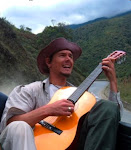Buenas,
OK so what was it that took me to Los Cedros???
well, a young mycologist from the royal ontario museum in toronto took an interest in the orchid genus Dracula.
why would a mushroom systematist care about orchids? one might wonder.
well in this particular genus, most species have labellums, or lower lips, that very much resemble small mushrooms. this resemblance has been shown to be chemical as well as visual through the work of an inspired swiss perfumer.
´´if they look like mushrooms, how can you tell that they are orchids?´´
so queried one puzzled aquaintance.........hhhhhhhmmmmm......
why would an orchid care to appear like a fungus?
well it turns out that there is a group of gnats --- the so-called fungus gnats --- that use small mushrooms to copulate in and then subsequently to raise their young in --- ´´brood sites,´´ in the biological parlance.
now if you were an orchid that looked and smelled like a mushroom.......at least good enough to fool a fungus gnat.......you might be able to take advantage of this domestic visitation to have your pollinia (the fancy name for the sacs of pollen in the orchidaceae) moved to the receptive stigma of another flower.....thus cross-pollinating.....and ensuring the genetic diversity necessary to resist the myriad pressures of day to day exsistance in this wet, warm, pathogen rich habitat.......
´´you mean even in nature everyone´s pretending to be something their not just to get laid?´´ quiped my gay electrician friend........
in fact deceptive pollination is thought to be a major driver of the remarkable diversity achieved in the orchidaceae, one of the, if not the biggest plant families in the world............
so this rare example of fungal brood site mimicry caught the attention of this young mycologist, and with a little help he was able to convince the national geographic society that this phenomena was worth studying..........
as for me.....right time, right place?
the woman he brought on board to collaborate happened to be my honors thesis advisor.........
my (at least cursory) familiarity with the cloud forest flora, ability to speak spanish, and general willingness to work in less than comfortable field conditions landed me an invitation to tag along......
so there i was heading into the clouds with an team of 5 other researchers including our local contact from the herbario nacional in quito, deep mushroom heads and excited plant ecologists................
head in the clouds, but feet firmly stuck in the mud!!!!!!!
fascinating to hang with these guys who were at least as into mushrooms as i am into plants.....a whole different lense......one that expanded my own appreciation.....
got to taste garlic flavored purple puffballs of dubious edibility, in the genus morganella.....
for the first time in my life i ate psuedohydnum gelatinosum........(a clear, gelatinous, toothed fungi, with a hymenium about the texture of a slimy cats tongue...hhhmmm..)......simply for the sake of helping to prove its edibility to our skeptical local guide.....it never occured to me to try this species in oregon where it is common.......although i have come to learn that they are not half bad soaked in cranberry juice and vodka!!!.......(purely anecdotal lol)
yes, deep mushroom heads......
but i digress...................
so fungal mimicry........an adaptive story alluring enough to get into text books, but never seriously studied (pet peeve of Gould and others)........so what do we have to do to provide support for this hypothesis?
our first line was to establish that the orchids and possibly model mushrooms even co-occured in time and space
check
then we looked at visitors. did the same gnats actually visit the orchids and the mushrooms?
check
were these gnats vectors of pollinia?
check
by covering flowers with bags and assessing visitation, we were able to ask: are olfactory cues important as well as visual cues?
check
still in the works is the identification of the aromatic compounds emmitted by these flowers and some of the mushrooms that were at least good visual candidates for models.....enter same inspired swiss perfumer (google roman kaiser for interesting tid-bits)......
a few other things in the works including a breeding system experiment to determine the abilty of the orchid to to self pollinate
preliminary population genetics inquiry..........we have the dna.....or at least some of it...
are these results specific to the species we looked at, or can we generalize across the genus?
some of this stuff is going to have to wait for further funding.....hopefullly from the national science foundation.......but we likely have got at least one paper out of the project so far.....
stay tuned for publication announcement!!!!!
so far though the adaptive story-telling has been largely supported.......
lovely when things make sense, no?
possible the beginning of a bigger story
more soon
paz
t
ps pix to follow.................
Suscribirse a:
Enviar comentarios (Atom)





No hay comentarios:
Publicar un comentario